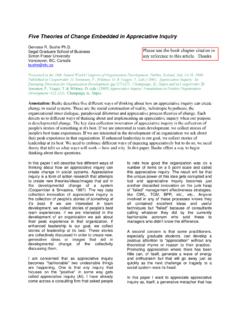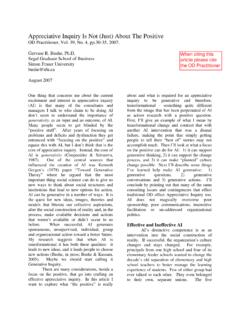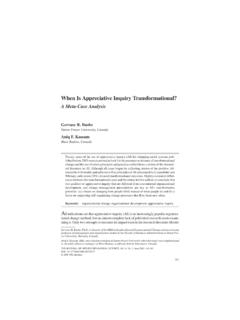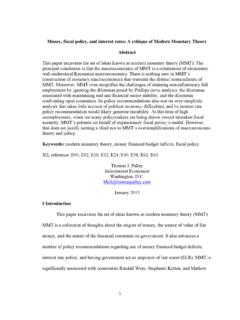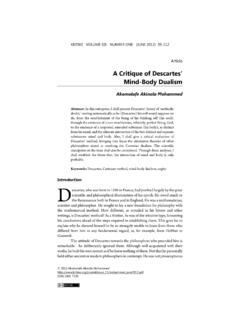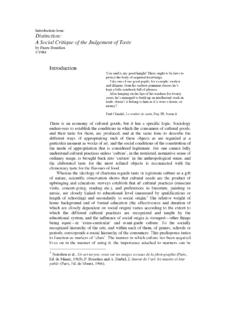Transcription of Appreciative Inquiry: Theory and Critique - Gervase Bushe
1 Appreciative inquiry : Theory and Critique When citing this paper please use the following reference: Bushe , (2011) Appreciative inquiry : Theory and Critique . In Boje, D., Burnes, B. and Hassard, J. (eds.) The Routledge Companion To Organizational Change (pp. 87 103). Oxford, UK: Routledge. Appreciative inquiry (AI) was one of the first post Lewinian Organization Development methods and probably catalyzed the subsequent proliferation of Dialogic OD methods ( Bushe & Marshak, 2009) that operate outside the Lewinian paradigm. Firmly grounded in social constructionist Theory (Gergen 1978; 2009), AI emerged out of the Department of Organizational Behavior (OB) at Case Western Reserve University in Cleveland Ohio and many academic writers on AI received their doctorates there ( , Barrett, Bright, Bushe , Carter, Cooperrider, Johnson, Ludema, Powley, Sekerka, Stavros, Thatchenkery).
2 Eschewing diagnosis as a necessary or even useful step in organizational change, and incorporating post modern perspectives on narrative and discourse, (Barrett, Thomas & Hocevar, 1995) the original, seminal article on AI (Cooperrider & Srivastva, 1987) was a revolutionary statement and a precursor to later developments in positive organizational studies (Cameron, Dutton & Quinn, 2003) and the strengths based movement (Buckingham & Clifton, 2001; Cameron & Lavine, 2006) in American management. This review begins with a brief description of the AI method followed by the underlying theories of change that support AI practice and the rather scanty evidence that exists supporting them. This review will also consider moderators of AI practice, important critiques of AI, and conclude with some of the more pressing research questions that require addressing for a deeper understanding of how and when AI transforms organizations.
3 2 Bushe AI Theory and Critique The Method of Appreciative inquiry David Cooperrider, the creator of Appreciative inquiry , resisted writing a book on how to do AI until the turn of the millennium because he wanted people to focus on the philosophy behind this approach and not see it as a technique. As a result, many different ways of doing AI have proliferated and it is inaccurate to say AI is done in any one way. For the first 15 years or so AI practitioners based their methods on the initial set of 4 principles (Cooperrider & Srivastva, 1987) which stated that inquiry into the social potential of a social system should begin with appreciation, should be collaborative, should be provocative, and should be applicable. The original method called for a collective discovery process using 1) grounded observation to identify the best of what is, 2) vision and logic to identify ideals of what might be, 3) collaborative dialogue and choice to achieve consent about what should be, and 4) collective experimentation to discover what can be.
4 It wasn t until 1997 that the 4 D model of AI, now almost universally described as the AI method, was created. Diana Whitney, Cooperrider s collaborator on some of the first AI projects in the 1990 s, had a major impact on the evolution of the practice of AI and the most authoritative sources on AI practice are Cooperrider, Whitney & Stavros (2008), Ludema, Whitney, Mohr & Griffen (2003), and Whitney & Trosten Bloom (2003). The general outline of the 4D method is as follows. 1) Discovery. During this stage participants reflect on and discuss the best of what is concerning the object of inquiry . Sometimes it is an inquiry into the life giving properties of the organization (Cooperrider & Srivastva, 1987). Sometimes it is the positive core (Cooperrider & Whitney, 2001), where an attempt is made to catalogue the signature strengths of the organization (Ludema et al, 2003).
5 Other times it is a specific capacity or process. For example, if the inquiry is about improving customer service, participants might inquire into their best experiences as a customer, or the best experiences of their customers, or study the best customer service organizations they can find. The extent to which the 3 Bushe AI Theory and Critique fruits of this inquiry are then analyzed or summarized varies widely by application. Most often (and this appears to be a key innovation of the AI method) participants are interviewed about their own best of experience. Another important innovation has been to have organizational stakeholders act as both interviewers and interviewees, that is, to fully engage all members in the act of inquiry itself (Carter & Johnson, 1999).
6 2) Dream. During this stage participants are asked to imagine their group, organization or community at its best and an attempt is made to identify the common aspirations of system members and to symbolize this in some way. The amount of preparation and the degree to which clarity about that common dream are sought vary widely by application. The dream phase often results in something more symbolic, like a graphical representation, than a mission statement. 3) Design. With a common dream in place, participants are asked to develop concrete proposals for the new organizational state. Initially Cooperrider called these provocative propositions a phrase linked to generative Theory (discussed below) that still appears in some models. More commonly, social architecture processes are employed where a model of design elements is used to identify categories for participants to organize around and create change proposals, often called possibility statements or design statements.
7 (Mohr, McLean & Silbert, 2003; Watkins & Mohr, 2001). Often, participants self select into small groups to develop specific proposals within a specific category The design company, IDEO (Brown, 2009), has been both a source of ideas and a participant in the evolution of the design phase of AI, and use of rapid prototyping processes is increasingly common. 4) Delivery/Destiny. In the initial 4 D model the fourth stage was called Delivery but this was subsequently changed by Cooperrider to Destiny as he found that Delivery evoked images of traditional change management implementation. Exactly what ought to happen in this phase has provoked the most confusion and the least consensus amongst AI advocates who recognize that using the outcomes 4 Bushe AI Theory and Critique of Design to create new targets, gaps to fill, and objectives to achieve is counter to the very philosophy of Appreciative inquiry .
8 At the same time, one of the most common complaints about AI from users is that while energy for change is high after the Design phase, implementation can be very spotty. Building on Barrett s (1998) work on improvisational processes in organizations, Bushe (2007, 2011, Bushe & Kassam, 2005) has described an improvisational as opposed to implementation approach to Destiny consistent with a vaguely developing consensus on the topic. In this approach, widespread agreement for the design statements are sought, an event is orchestrated where participants make self chosen, personal commitments to take action consistent with any design element, and leadership makes clear that there will be no action plans or committees instead everyone is authorized to take those actions they believe will help bring the design to fruition.
9 Leadership s role then becomes tracking and fanning ( Bushe , 2009), finding and amplifying those innovations they want to nurture and creating events and processes to energize self organizing momentum. A number of practitioner critiques pointed out that the 4D model omitted an important first step in the AI process of identifying the focus of the inquiry itself. The Clergy Leadership Institute in the suggested Define as the first step and some AI models refer to a 5 D model. Cooperrider s dissertation called this the affirmative topic and many models have retained that label. How, exactly, that topic is defined has not been well articulated but is generally regarded as essential to the overall success of the effort. Engaging the right people, especially powerful sponsors, in identifying a focus that is both of high interest to those leading the organization and will be compelling to stakeholders is commonly held to be critical to overall success (Barrett & Fry, 2005).
10 Whitney & Trosten Bloom (2003) identified 8 forms of engagement used by AI practitioners. These ranged from interventions where a sole consultant or a small representative group of people do the AI on behalf of a larger group of people to those where most or all of the whole system is engaged in the 5 Bushe AI Theory and Critique entire 4 D process. The majority of case studies of transformational change have been of the latter variety (Barrett & Fry, 2005; Barros & Cooperrider, 2000; Bushe & Kassam, 2005; Fry et. al., 2002; Ludema et. al., 2003; Ludema & Hinrichs, 2003; Powley, Fry, Barrett & Bright, 2004) leading to an increasing emphasis in the AI literature on widespread engagement as central to successful AI change efforts ( Bushe , 2011; Cooperrider & Sekerka, 2006; Cheung Judge & Powley, 2006).

